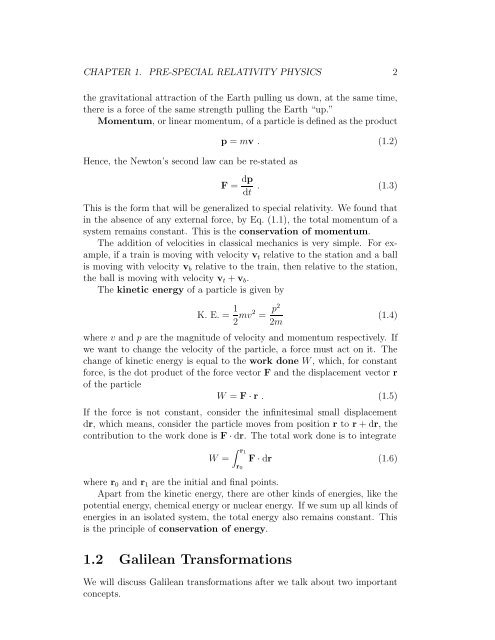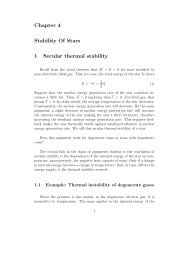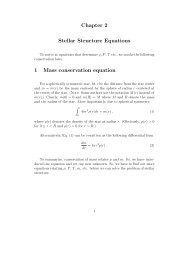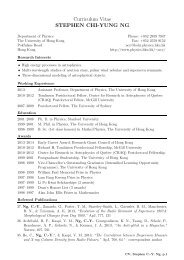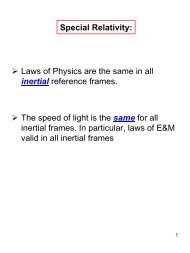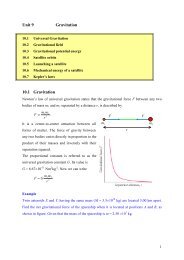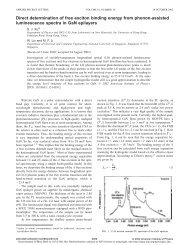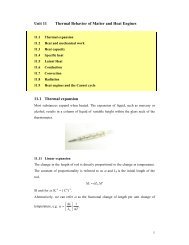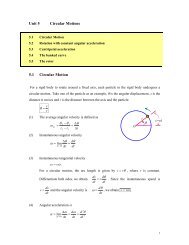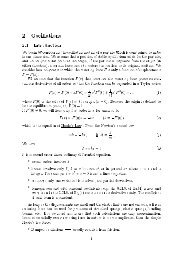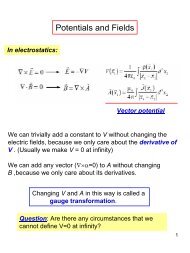here - Department of Physics, HKU
here - Department of Physics, HKU
here - Department of Physics, HKU
You also want an ePaper? Increase the reach of your titles
YUMPU automatically turns print PDFs into web optimized ePapers that Google loves.
CHAPTER 1. PRE-SPECIAL RELATIVITY PHYSICS 2<br />
the gravitational attraction <strong>of</strong> the Earth pulling us down, at the same time,<br />
t<strong>here</strong> is a force <strong>of</strong> the same strength pulling the Earth “up.”<br />
Momentum, or linear momentum, <strong>of</strong> a particle is defined as the product<br />
Hence, the Newton’s second law can be re-stated as<br />
p = mv . (1.2)<br />
F = dp<br />
dt . (1.3)<br />
This is the form that will be generalized to special relativity. We found that<br />
in the absence <strong>of</strong> any external force, by Eq. (1.1), the total momentum <strong>of</strong> a<br />
system remains constant. This is the conservation <strong>of</strong> momentum.<br />
The addition <strong>of</strong> velocities in classical mechanics is very simple. For example,<br />
if a train is moving with velocity v t relative to the station and a ball<br />
is moving with velocity v b relative to the train, then relative to the station,<br />
the ball is moving with velocity v t + v b .<br />
The kinetic energy <strong>of</strong> a particle is given by<br />
K. E. = 1 2 mv2 = p2<br />
2m<br />
(1.4)<br />
w<strong>here</strong> v and p are the magnitude <strong>of</strong> velocity and momentum respectively. If<br />
we want to change the velocity <strong>of</strong> the particle, a force must act on it. The<br />
change <strong>of</strong> kinetic energy is equal to the work done W, which, for constant<br />
force, is the dot product <strong>of</strong> the force vector F and the displacement vector r<br />
<strong>of</strong> the particle<br />
W = F · r . (1.5)<br />
If the force is not constant, consider the infinitesimal small displacement<br />
dr, which means, consider the particle moves from position r to r + dr, the<br />
contribution to the work done is F · dr. The total work done is to integrate<br />
W =<br />
∫ r1<br />
r 0<br />
F · dr (1.6)<br />
w<strong>here</strong> r 0 and r 1 are the initial and final points.<br />
Apart from the kinetic energy, t<strong>here</strong> are other kinds <strong>of</strong> energies, like the<br />
potential energy, chemical energy or nuclear energy. If we sum up all kinds <strong>of</strong><br />
energies in an isolated system, the total energy also remains constant. This<br />
is the principle <strong>of</strong> conservation <strong>of</strong> energy.<br />
1.2 Galilean Transformations<br />
We will discuss Galilean transformations after we talk about two important<br />
concepts.


